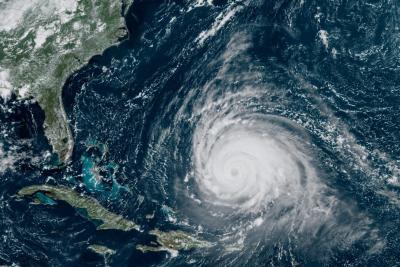Stronger Sea Surface Cooling Produced by Hurricanes along the U.S. Southeast Coast
Hurricanes rapidly cool the sea surface by mixing cooler, deep waters with warmer surface waters. The upper-ocean temperature and distribution of nutrients are significantly altered in the aftermath of these large weather events—this is known as a “cold wake.” This study addressed how cold wakes have changed from 1982–2020, specifically along the U.S. Southeast and Gulf Coasts. Researchers found that storm-induced sea surface cooling increased significantly along the nearshore regions of the Southeast Coast by ~0.20 ºC, but changes along the Gulf Coast were weak. Climate models show that anthropogenic forcings have likely enhanced the cold wake trend observed in the Southeast via increased alongshore winds and the consequent shoaling of the coastal thermocline, placing colder water nearer to the sea surface.
How the surface and subsurface oceanic environments may change in nearshore regions is not well understood in the context of global warming, despite their influence on the sea surface response to passing hurricanes. Researchers in this study analyzed multi-decadal changes in the sea surface temperature response to hurricanes along the U.S. Southeast and Gulf Coasts. Their research shows that the upper-ocean cooling induced by hurricanes along the U.S Southeast Coast has increased significantly over the past three decades. This study also highlights the intricate dynamics of coastal processes associated with changes in atmospheric circulation as a mechanism for the increase in cold wakes.
Utilizing satellite observations and ocean reanalysis datasets, researchers analyzed the change in sea surface cooling induced by hurricanes and the corresponding ocean-atmosphere environment along the Gulf and Southeast coastal regions of the United States. The magnitude of sea surface cooling increased by about 0.20 °C in the nearshore regions of the Southeast Coast over the period 1982–2020. However, there was no significant change in storm-induced cooling along the Gulf Coast, which highlights the regional nature of these responses to global warming.
To gain a mechanistic understanding of the physical processes responsible for the enhanced hurricane cold wakes near the Southeast United States, investigators used ocean reanalysis datasets. An examination of the oceanic environment revealed that the increased magnitude of cold wakes along the Southeast Coast has likely resulted from a cooling of subsurface waters in that region. Further analysis suggests that the latter can be attributed to an increase in pressure gradient across the land-sea boundary. This results in a strengthening of alongshore winds, which in turn increases upwelling of colder subsurface water. The results from the Coupled Model Intercomparison Project Phase 6 (CMIP6) models indicate that anthropogenic forcings are likely driving these changes in the atmospheric circulation along the Southeast Coast. These findings shed light for the first time on how interactions between hurricanes and upper-ocean conditions are changing under a warming climate near the U.S. Southeast Coast.

